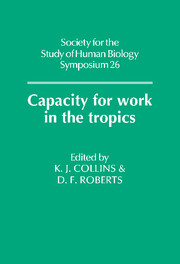Book contents
- Frontmatter
- Contents
- Preface
- Measurement of Working Capacity in Populations
- Work capacity: methodology in a tropical environment
- Ventilatory capacity in tropical populations: constitutional and environmental influences
- Is measurement of aerobic capacity a realistic objective?
- Functional Consequences of Malnutrition
- Growth, Stature and Muscular Efficiency
- Ethnic and Socio-Cultural Differences in Working Capacity
- Energy Expenditure and Endemic Disease
- Research Models in Tropical Ecosystems
- Index
Work capacity: methodology in a tropical environment
Published online by Cambridge University Press: 15 March 2010
- Frontmatter
- Contents
- Preface
- Measurement of Working Capacity in Populations
- Work capacity: methodology in a tropical environment
- Ventilatory capacity in tropical populations: constitutional and environmental influences
- Is measurement of aerobic capacity a realistic objective?
- Functional Consequences of Malnutrition
- Growth, Stature and Muscular Efficiency
- Ethnic and Socio-Cultural Differences in Working Capacity
- Energy Expenditure and Endemic Disease
- Research Models in Tropical Ecosystems
- Index
Summary
INTRODUCTION
The tropical habitat currently faces strong pressures. In many parts of Africa, the current growth rate for human populations is 4.5–5.0% per annum, compared with the world average of 1.7%. While there remains some disagreement on minimal nutritional requirements (Rivers & Payne, 1982; Weymes, 1982), the expanding deserts of the sub-Saharan poverty belt threaten starvation to many peoples of this region. At the same time, large parts of the African continent have very few inhabitants. In the “Decade of the Tropics” much thus depends on human ability to exploit the African habitat, producing a surplus of food that can nourish rapidly expanding cities.
One important determinant of the ability to colonize any harsh environment is the individual's physiological working capacity (Harrison & Walsh, 1974; Shephard, 1978), the “ability to perform muscular work satisfactorily” (Andersen et al, 1971). In this review, particular attention will be paid to developments since completion of the International Biological Programme (LB.P., Worthington, 1978). The changing nature of work capacity will be discussed in a tropical context, along with issues such as sampling bias, technical problems of measurement in a hot environment, and procedures for allocating variance between constitution and environment. The effect of changes in body size, nutrition and health will also be considered briefly.
THE CHANGING NATURE OF WORK CAPACITY
The physiological characteristics appropriate to successful colonization of a given habitat depend on (i) population pressures, (ii) the amount of physical work necessary for survival, and (iii) available technology (Breymeyer & Van Dyne, 1979).
- Type
- Chapter
- Information
- Capacity for Work in the Tropics , pp. 1 - 30Publisher: Cambridge University PressPrint publication year: 1988
- 1
- Cited by

